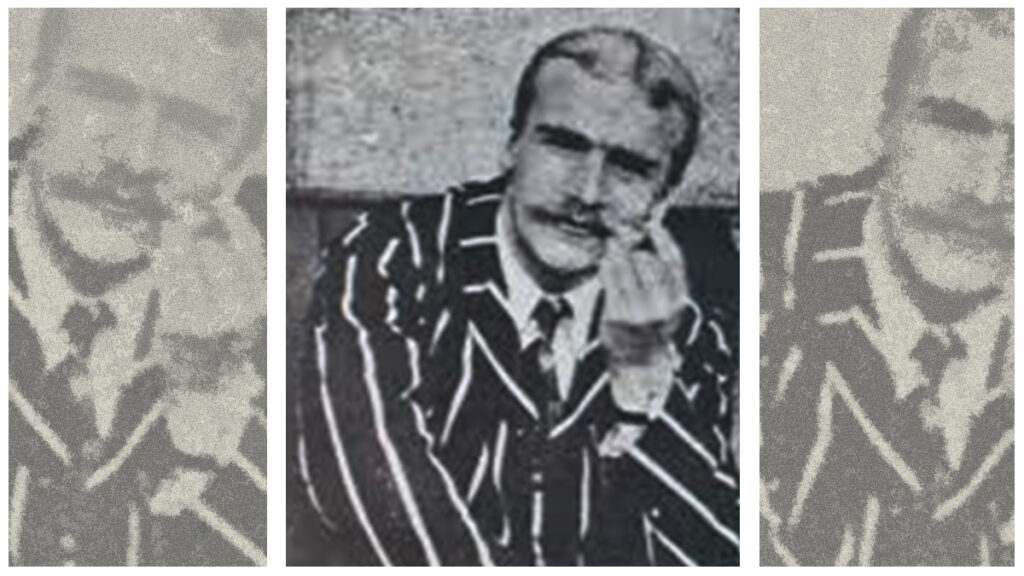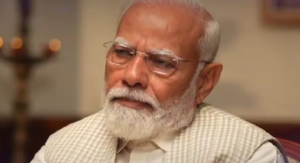Book Review: Samanth Subramanian, ‘A Dominant Character: The Radical Science and Restless Politics of J. B. S. Haldane’ (New York: Norton, 2020), 384 pages, $40, hardcover.
By any standards, John Burdon Sanderson Haldane (1892–1964) was a fascinating man. An eminent scientist, prolific writer and speaker, fiery political activist, and all-round colorful character, he has been the subject of several full-length biographies and multiple biographical sketches.[1] There have also been fictional characters in novels based on him.
From beginning to end, his life was full of adventure—as a cutting-edge scientist who fearlessly experimented on himself (despite resultant damage to his health), a combatant in several wars, a respondent in a scandalous divorce case, a professor pushing against the constraints of academe, a communist tracked by intelligence agents wherever he went, and a public intellectual vigorously polemicizing on a vast array of issues.
Haldane was born into the Scottish intellectual elite. His father John Scott Haldane was a prominent scientist who enlisted him as a child into his scientific experiments, where his habit of experimenting on himself began. Though his father was a liberal in politics and an idealist in philosophy (devoted to undermining materialism in philosophy of science), his mother was a conservative devoted to the values of the British empire. She too recruited her son into her activities. But as he developed, he chose his own way.
Haldane was educated at Eton and Oxford, but also interacted with miners, sailors, railway-men, and soldiers through his work as an apprentice scientist in his father’s experiments and his exposure to the camaraderie of the battlefields of war. Though he was a working scientist from his youth until his death, he never received a degree in science. Instead, he opted for “Greats” at Oxford University, a degree in classics, history, and philosophy, reflecting his reach for breadth of knowledge and resulting in wide-ranging references to ancient history, literature, and philosophy throughout his speeches and texts.
As Samanth Subramanian outlines in A Dominant Character: The Radical Science and Restless Politics of J. B. S. Haldane:
In magazines and newspapers, Haldane wrote about everything. He wrote cutting opinion pieces on politics—like razor blades in print. He wrote about his own boisterous life, which was stocked with enough danger and drama for a dozen ordinary humans.… He wrote of his views on governments and philosophies, and he wrote about history and literature. He wrote a book for children…and most of a science fiction novel. But mainly, he wrote columns that unpicked the convolutions of science for the inexpert reader.… On every front of science, he seemed to know of every journal article being published, every item of research being conducted, as if scientists confided their dreams to him every morning before heading off to their laboratories.… His voice filled the room as he quoted Dante, Norse myth, and the Bhagavad Gita from memory, beckoning with ease his knowledge of genetics, chemistry, history, and astronomy.[2]
While he earned his living as an academic, he was an uncomfortable presence in university life, especially as he had been to war, was active in politics, and touched life at so many other points beyond the sheltered gentility of the common room, where he often introduced discourse “like boulders onto porcelain.” He was dismissed from his position at Cambridge by the sex viri (six men, irreverently called the “sex weary,” who acted as the university’s moral guardians) for “gross or habitual immorality,” because he had a notorious adulterous affair with a married woman (they arranged to be caught so that she could obtain a divorce). Haldane fought the dismissal, with the support of his union, the Association of Scientific Workers, and had it overturned, establishing the principle of university noninterference in the private life of staff. When he was a professor at University College London, he was constantly embattled over resource allocations and a range of other matters.
Haldane wanted science to sweep out of the laboratory and into the world, and he did everything in his power to make this happen, including contributing a regular science column in the Daily Worker. In his expositions, he strove for generality and simplicity, as well as vividness and precision.
His scientific work was focused on genetics, which was at the time still in the process of defining itself. Within the field, Haldane’s work ranged from specific phenomena to fundamental theory. He mapped the genes for hemophilia and color blindness, demonstrated the mechanism of genetic linkages, modeled the rates at which gene mutations developed and spread through populations, formulated a theory on the biochemical origin of life on earth, and contributed to the modern synthesis of genetics and evolution.
His synthesizing impulse—which extended beyond science, reaching for a theory of everything, from the beginning of time to the end of the world—found a home in Marxism. Haldane saw Marxism as the scientific method applied to society, expressing the unity of all knowledge, analyzing the same fundamental processes intermeshing into each other in every cross-section of nature and society. For Haldane, there was no hermetic boundary between science and politics. Those who thought otherwise were deluded, because “even if the professors leave politics alone, politics won’t leave the professors alone.”
A Dominant Character is a well-written and well-researched biography. Subramanian is strongest in explaining Haldane’s science and weakest in understanding his philosophy.[3] While he does make a sincere effort to come to grips with Haldane’s philosophy, mostly out of respect for his impressive subject, at times he slips into caricature, as if using the term diamat (a crude portmanteau of dialectical materialism) itself makes the case that dialectical materialism is an unsophisticated and disreputable philosophical position. As he characterizes it: “Most of [Haldane’s] correlations between Marxism and science went like this, formulated cleverly and lit by a slight flame of insight, but made plausible only because the language of diamat was so baggy, so easy to wrap around nearly anything. With Marxism as a tool of analysis, Haldane felt able to integrate all his ideas, all his interests.”[4]
In contrast, in his review of Haldane’s book The Marxist Philosophy and the Sciences, Andrew Rothstein concluded: “Like anyone on his first acquaintance with the Marxist method, thunderstruck at the new worlds which that touchstone opens in seemingly familiar things, Haldane hastens to run over the whole range of his knowledge, calling ‘Open Sesame’—with great profit to himself and his audience.”[5]
In Subramanian’s stance toward his subject, his biography of Haldane reminded me of Andrew Brown’s biography of John Desmond Bernal, who was part of the same milieu and shared the same intellectual positions and political commitments as Haldane. J. D. Bernal: The Sage of Science is a work of massive scholarship in which Brown shows great admiration for Bernal as a scientist and fascination with many aspects of his life, but is bewildered by his Marxist philosophy.[6] Many reviewers of the book echoed the attitude. A generation later, many took the same stance toward scientists such as Richard Lewontin, Richard Levins, and Stephen Jay Gould, whose contributions to science were respected, but whose adherence to Marxism was seen as an aberration, despite their insistence that their science, philosophy, and politics were integrally and organically interrelated.
This is not to say that there were never points of tension. The Lysenko controversy—a protracted episode in Soviet history where complex issues of science, politics, and philosophy came into play—did present Haldane with a conflict between his science and his politics, which he navigated with great difficulty. Indeed, as Subramanian rightly asserts, it presented Haldane with his greatest moral crisis. This is a matter often subjected to crude caricature. To his credit, Subramanian takes great care to explore all its nuances, complications, and contradictions. The controversy is often presented as a story of personal opportunism and political terror, a cautionary tale against the dangers of bureaucratic interference in intellectual life or of ideological distortion of science. These are obviously elements of an analysis, but far from the whole story. T. D. Lysenko was a charlatan and his drive against geneticists, coinciding with Stalinist purges, had disastrous consequences for science. However, it is necessary to see the emergence of Lysenkoism as no historical accident, as no imposition of alien elements (philosophy and politics) on science.
In reality, it was a movement reflecting the temper of the times and groping with very real problems within science itself, as well as with the tasks of political and cultural revolution, the drive to create a socialist intelligentsia, and the push to transform every sphere of life and thought (including science and agriculture) in a new social order. Such tasks naturally involved struggling with such issues as the ideological character of science, hereditarianism versus environmentalism, determinism versus voluntarism, the relationship of philosophy to biology, and the relationship of biology to agronomy.
Subramanian skillfully rejects the standard flattened narrative and argues that science in the 1940s was full of superheated debate and there has never been, anywhere, such a thing as pure science untouched by the politics of its age. In this way, he takes care to explore key global scientific debates and political contexts.
Haldane had gone to the Soviet Union in 1929, invited by Nikolai I. Vavilov, world-renowned geneticist. He was mightily impressed by it as a vast social experiment, in which science was playing a powerful and crucial role. He believed that the Soviet Union was taking science seriously and funding it accordingly in a way that outstripped Britain and everywhere else many times over. When his wife Charlotte later returned as a journalist and was disturbed by much of what she saw, including the deteriorating situation of scientists, Haldane refused to accept it. She left the Communist Party, but Haldane joined it in 1942, although he had been a Marxist and fellow traveler for some years before that. He was on the executive committee of the party and editorial board of its newspaper, the Daily Worker.
On the matter of Lysenko, he equivocated. He was inclined to give the USSR and Communist Party of Great Britain the benefit of the doubt on most matters—even this—but genetics was at the core of his life and work, and he never defended attacks on genetics or statistics. He raised criticisms of Lysenko, but also bent over backward to find positives to praise. As to the fate of scientists during the purges, including his friend Vavilov who was arrested in 1940, he backed off from making any public comment, so as not to give the enemies of communism any satisfaction.
At first, Haldane characterized the controversy as healthy scientific debate, but, as time went on and it became clear that it was something different, he burst out with forthright flares of repudiation of key tenets of Lysenkoism. Neither the equivocation nor the criticism were acceptable to the party. When the Daily Worker issued a commentary on Lysenko and genetics without consulting Haldane, although he was chair of its editorial board, he was enraged. When the Engels Society, a group of Marxist scientists, drew up a draft of a statement entitled “In Support of Lysenko,” he stated that he was in absolute disagreement. Haldane began pulling away from the party and finally left it.
Having become alienated from Britain, especially after the Suez crisis in 1956, and from the Soviet Union, during the protracted Lysenko affair, he looked for an alternative source of inspiration and social transformation. He found this in India. Although 65 years old in 1957, when he might have been expected to be winding down and basking in his achievements, even retiring, he moved to another continent and took up a new position of academic leadership. Haldane saw postindependence India under Jawaharlal Nehru as a petri dish for scientific socialism, a vast experiment to see how science could lift the lives of hundreds of millions of people. The Nehru government adopted Soviet principles of centralized economic planning, which put a high premium on theory and data, within which the Institute of Statistics, where Haldane was a professor, played a crucial role. Never one for half measures, Haldane threw himself into this monumental project while also immersing himself in local languages, customs, cuisines, and clothing.
Meanwhile, genetics was taking a new turn, requiring advanced technical facilities and deep pocket funding not available to Haldane. He continued to do basic science in his own way, ranging from the practicalities of plant and animal breeding to high theory, until the end, when colorectal cancer ended his life. His contributions to knowledge lived on, not only in willing his organs to science, but leaving a legacy leading to books still being written about him, decades after his death.
Notes
- Ronald Clark, B. S.: The Life and Work of J. B. S. Haldane (Oxford: Oxford University Press, 1984); Krishna Dronamraju, The Life and Work of J. B. S. Haldane with Special Reference to India (Aberdeen: Aberdeen University Press, 1985); Gary Werskey, The Visible College: The Collective Biography of British Scientific Socialists of the 1930s (New York: Holt, Rinehart and Winston, 1978).
- Samanth Subramanian, A Dominant Character: The Radical Science and Restless Politics of J. B. S. Haldane (New York: Norton, 2020), 4–5.
- For a more sympathetic treatment of his philosophy, see John Bellamy Foster, The Return of Nature: Socialism and Ecology (New York: Monthly Review Press, 2020); Helena Sheehan, Marxism and the Philosophy of Science (London: Verso, 2018).
- Subramanian, A Dominant Character, 174.
- Andrew Rothstein, “Vindicating Marxism,” Modern Quarterly 3 (1939): 290.
- Andrew Brown, D. Bernal: The Sage of Science (Oxford: Oxford University Press, 2005).
(Helena Sheehan is professor emerita at Dublin City University, where she taught history of ideas and media studies. She is also the author of several books. Courtesy: Monthly Review, a famed socialist journal published from New York.)




